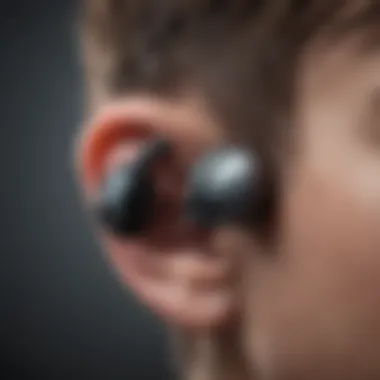Analyzing the Effects of Removing Headphone Plug from iPhone 7: A Comprehensive Insight


Product Overview
As we delve into the impact of Apple's bold decision to remove the headphone plug on the iPhone 7, it becomes imperative to understand the product itself comprehensively. The iPhone 7, released in September 2016, was a pivotal moment in Apple's history. Among its distinguishing features were the powerful A10 Fusion chip, a 12-megapixel camera, and a redesigned pressure-sensitive Home button. The iPhone 7 showcased Apple's commitment to innovation and design excellence.
Performance and User Experience
The performance benchmarks of the iPhone 7 were exceptional during its time. Users were impressed by its smooth operation and responsiveness, thanks to the A10 Fusion chip. The user interface was intuitive and seamlessly integrated with the hardware, providing a cohesive user experience. Feedback from users highlighted the device's reliability and durability, establishing it as a formidable contender in the smartphone market.
Comparison with Previous Models or Competitors
When comparing the iPhone 7 to its predecessors, notable advancements included improved camera capabilities, better battery life, and enhanced processing power. In a competitive landscape, the iPhone 7 stood out for its seamless integration of hardware and software, setting a new standard for smartphone performance. Its value proposition lay in the combination of cutting-edge technology and sleek design aesthetics.
Tips and Tricks
For enthusiasts looking to optimize their iPhone 7 experience, there are various tips and tricks available. From enhancing camera settings to maximizing battery life, users can explore hidden features and functionalities that amplify the device's utility. Troubleshooting common issues ensures a smoother user experience, offering solutions to potential hitches users may encounter.
Latest Updates and News
Staying updated with the latest developments is crucial for avid Apple followers. Recent software updates for the iPhone 7 brought new features and enhancements, enhancing the device's performance and functionality. Industry rumors and upcoming product speculations also fueled excitement among tech enthusiasts, keeping them engaged with the dynamic world of Apple.
Exploring the Impact of Removing the Headphone Plug on iPhone
Foreword
In this article, we delve deep into the repercussions and implications of Apple's pivotal decision to eliminate the headphone plug from the iPhone 7. This move shook the tech industry, sparking debates on design philosophies and user adaptability. Understanding the rationale and effects of this bold step by Apple is crucial for grasping the evolution of smartphone technology and user behavior. By dissecting the background, controversies, and alternatives linked to this decision, we aim to offer a thorough analysis of this significant event.
Overview of iPhone Headphone Plug Removal
Apple's Bold Move
Apple's decision to remove the headphone plug from the iPhone 7 marked a defining moment in smartphone design. This courageous move exemplified Apple's commitment to pushing technological boundaries and adapting to changing consumer needs. The elimination of the headphone jack underscored Apple's pursuit of sleeker, more efficient device designs. Although contentious at first, this choice symbolized a leap towards embracing wireless connectivity and streamlined device aesthetics. The unique feature of Apple's decision lies in its courage to disrupt the status quo and set new industry standards. While some users initially resisted this change, the benefits of improved water resistance and increased internal space became progressively evident.
Implications for Users
The implications of the headphone plug removal on users were profound. This alteration required users to transition to wireless audio solutions, thus reshaping how individuals interacted with their devices. While the shift posed initial compatibility challenges for existing headphones, it paved the way for a more coherent wireless ecosystem. Users had to reconsider their audio accessory choices, leading to the rise of Bluetooth headphones and Lightning connector earphones. The unique feature of this change was its impact on user behavior and preferences, emphasizing the adaptability of consumers to evolving technology landscapes.
Background Information


Evolution of Smartphone Design
The evolution of smartphone design has been a progressive journey towards enhancing device functionality and aesthetics. From bulky devices with limited capabilities to sleek, feature-rich smartphones, the industry witnessed a remarkable transformation. Smartphones evolved from mere communication tools to versatile companions, integrating advanced technologies for a seamless user experience. This change highlighted the industry's focus on innovation and user-centric design, with each iteration pushing boundaries and setting new benchmarks. The unique feature of this evolution is its continuous drive towards user satisfaction and technological advancement.
Shift Towards Wireless Technology
The shift towards wireless technology revolutionized how users interacted with their devices. Wireless connectivity offered unparalleled convenience and freedom, enabling users to untether from traditional wired constraints. This shift propelled the adoption of wireless peripherals and accessories, fostering a more streamlined and clutter-free user experience. While this transition initially posed challenges in terms of compatibility and standardization, it paved the way for a wireless-centric future. The unique feature of this shift is its transformative effect on user lifestyle and device usability.
Technological Aspect
The technological aspect plays a vital role in understanding the impact of removing the headphone plug from the iPhone 7. This move by Apple signifies a paradigm shift in smartphone design, emphasizing the transition towards wireless connectivity. By delving into the technological aspect, we uncover the significance of features such as enhanced water resistance and increased internal space. These advancements not only enhance the user experience but also set a new standard for smartphone functionality. Exploring the technological aspect provides valuable insights into the evolution of smartphone technology and its implications for future innovations.
Advantages of Removing Headphone Plug
Enhanced Water Resistance
Enhanced water resistance is a crucial benefit of removing the headphone plug from the iPhone 7. This feature ensures that the device is more durable and can withstand exposure to moisture, making it ideal for various environments and usage scenarios. The key characteristic of enhanced water resistance lies in its ability to protect internal components from damage caused by water ingress. This advantage is particularly popular among users who require a rugged and reliable smartphone, underscoring its importance in reinforcing the device's longevity and reliability.
Increased Internal Space
Increased internal space is another notable advantage resulting from the removal of the headphone plug. This additional space allows for the integration of advanced components and technologies, leading to improved performance and enhanced functionalities. The key characteristic of increased internal space is its capacity to accommodate larger batteries or additional features without compromising the device's slim profile. This benefit is particularly significant for users who prioritize both sleek design and enhanced capabilities, highlighting the practicality and innovation enabled by this design choice.
Challenges and Limitations
Compatibility Issues
Compatibility issues emerge as a challenge following the removal of the headphone plug from the iPhone 7. Users may encounter difficulties connecting non-wireless audio devices to the device, requiring additional adapters or accessories to maintain compatibility. The key characteristic of these compatibility issues is their impact on user convenience and versatility, posing a potential barrier to seamless audio connectivity. Despite this limitation, advancements in wireless technology aim to mitigate compatibility concerns and promote a more streamlined user experience in the long run.
Transition to Wireless Ecosystem
The transition to a wireless ecosystem presents another challenge associated with removing the headphone plug. This shift necessitates users to adapt to wireless audio solutions, such as Bluetooth headphones or Lightning connector earphones. The key characteristic of this transition is its role in shaping user behavior and preferences towards wireless accessories, marking a departure from traditional wired connections. While the transition offers increased mobility and flexibility, some users may face a learning curve in adjusting to new audio technologies, illustrating the evolving landscape of smartphone accessories and connectivity.
Exploring the Impact of Removing the Headphone Plug on iPhone
Consumer Behavior Analysis
Consumer Behavior Analysis plays a pivotal role in unraveling the intricate dynamics following Apple's daring move to eliminate the headphone plug from the iPhone 7. Understanding how users perceive and adapt to this technological shift provides invaluable insights into market trends and user preferences. By delving into users' reactions and feedback, we can decipher the acceptance, resistance, and the impact on the audio accessories market.
User Reactions and Feedback


Acceptance vs. Resistance
In scrutinizing the spectrum of reactions towards Apple's decision to bid adieu to the conventional headphone plug, it becomes evident that there exists a dichotomy between acceptance and resistance. Acceptance signifies the embrace of change, appreciating Apple's vision for innovation. On the contrary, resistance embodies a reluctance toward this transition, clinging to familiarity and tradition. The dichotomy between these two polarizing stances encapsulates the essence of user responses, reflecting a marketplace divided by progressive adaptation and nostalgic adherence.
Impact on Audio Accessories Market
The reverberations of Apple's pivotal choice seismically reverberate through the audio accessories market, reshaping consumer preferences and industry dynamics. The displacement of the headphone plug catalyzes a surge in demand for wireless alternatives, propelling Bluetooth headphones and Lightning Connector Earphones to the forefront. This paradigm shift not only amplifies the utility of wireless technologies but also underscores the resilience and adaptability of the consumer electronics market in response to disruptive innovations.
Adoption of Wireless Alternatives
Bluetooth Headphones
Among the myriad of wireless alternatives poised to dominate the post-headphone plug era, Bluetooth headphones emerge as a frontrunner in revolutionizing audio consumption. The seamless integration of Bluetooth technology with unparalleled sound quality encapsulates the allure of these wireless companions, offering users a cord-free audio experience unbounded by traditional limitations. However, the trade-off between convenience and battery dependency underscores the need for users to recalibrate their audio consumption patterns in alignment with Bluetooth technology's nuances.
Lightning Connector Earphones
Conversely, Lightning Connector Earphones manifest as a distinctive breed of audio peripherals, tailored to synchronize harmoniously with Apple's proprietary ecosystem. The symbiotic relationship between Lightning Connector Earphones and Apple devices underscores a seamless audio experience enriched by enhanced connectivity and functionality. Nonetheless, the exclusivity of this ecosystem imposes limitations on cross-compatibility, delineating a nuanced landscape where user preferences coalesce with technological intricacies.
This meticulous exploration underscores the multifaceted repercussions ensuing from Apple's decision, illuminating an ecosystem where consumer behaviors intersect with technological innovations to sculpt the future of smartphone design and functionality.
Industry Impact
The Industry Impact section of this article delves into the profound implications of Apple's strategic move in eliminating the headphone plug from the iPhone 7. This landmark decision sent ripples through the tech sector, sparking a wave of innovation and adaptation among competitors. The repercussions were felt not only in consumer behavior but also in the design philosophies of rival manufacturers.
Competitor Responses
Emulation vs. Differentiation
The dichotomy between Emulation vs. Differentiation plays a pivotal role in how competitors responded to Apple's radical step. While some chose to emulate Apple's direction, incorporating similar alterations in their product lines, others opted for a path of stark differentiation, setting themselves apart in the market. Emulation signifies a desire to align with Apple's choices, often seen as a way to capitalize on established trends and consumer preferences. In contrast, Differentiation reflects a strategic divergence, leveraging unique features and design aspects to carve out a distinct identity.
Influence on Future Smartphone Designs
The Influence on Future Smartphone Designs aspect reverberated across the industry, shaping the trajectory of mobile technology. Companies scrutinized Apple's decisions closely, aiming to anticipate and adapt to emerging trends. Manufacturers focused on enhancing their offerings in line with the evolving landscape of smartphone features. The influence extended beyond just hardware alterations, sparking a reevaluation of user experience and design aesthetics.
Market Trends and Innovation
Shift Towards Wireless Connectivity


The shift towards Wireless Connectivity emerged as a dominant trend following Apple's headphone plug removal. This transition signaled a broader industry shift towards a wireless ecosystem, emphasizing convenience and mobility. Consumers embraced the freedom afforded by wireless solutions, driving a surge in demand for Bluetooth-enabled devices.
Focus on Audio Quality
The Focus on Audio Quality gained prominence as smartphone manufacturers vied to deliver a superior auditory experience. With the removal of the headphone jack, the spotlight shifted to optimizing sound quality through alternate mediums. Industry players prioritized advancements in audio technology, striving to compensate for the absence of traditional audio interfaces.
Controversies and Alternatives
In this article, the section focusing on Controversies and Alternatives plays a pivotal role in elucidating the multifaceted impact of eliminating the headphone plug from the iPhone 7. By delving into the controversies surrounding this decision and exploring the alternative solutions that emerged, a comprehensive understanding of the technological landscape post-headphone jack is attained.
Public Debate and Critiques
- Loss of Convenience: Within the realm of the contentious removal of the headphone plug, the Loss of Convenience stands out as a key aspect. The absence of the traditional headphone jack precipitated a paradigm shift in user experience, challenging the notions of ease and familiarity. This significant transformation sparked heated debates among consumers and tech experts alike, underscoring the intrinsic value users placed on the simplicity and ubiquity of the headphone plug.
- Issues with Dongle Adapter: Another crucial facet in the discussion on the repercussion of abolishing the headphone plug revolves around the Issues with Dongle Adapter. This dongle, serving as a bridging device between traditional headphones and the lightning port, introduced its own set of complexities. From potential loss or breakage to the need for an additional accessory, users found themselves grappling with newfound inconveniences caused by this transitional aid.
Alternative Solutions
- Third-Party Adapters: A notable alternative that emerged post the removal of the headphone plug was the Third-Party Adapters. These adapters served as a lifeline for users reluctant to part ways with their beloved wired headphones, offering a practical workaround to the compatibility conundrum. However, reliance on third-party solutions posed its own set of challenges, including issues of quality, durability, and seamless integration with the Apple ecosystem.
- Bluetooth Transmitters: Concurrently, the rise of Bluetooth Transmitters presented a wireless alternative to the traditional wired setup for audio enthusiasts. This technology not only encapsulated the essence of Apple's vision for a wireless future but also heralded a new era of uncompromised audio fidelity and seamless connectivity. Despite its cutting-edge appeal, Bluetooth Transmitters confronted criticisms regarding battery life, latency, and the need for device pairing, questioning the transition's overall convenience and user experience.
Ending
As we conclude this in-depth exploration of the impact of removing the headphone plug on the iPhone 7, it becomes evident that Apple's decision to eliminate this traditional audio port marked a pivotal moment in smartphone evolution. The repercussions of this bold move have reverberated throughout the industry, affecting consumer behavior, technological advancements, and market trends. By analyzing the various facets of this decision, from its initial announcement to the ongoing controversies and alternatives, we have gained a comprehensive understanding of the far-reaching implications of this significant shift.
Summary of Key Findings
Impact on User Experience
Focusing on the impact on user experience, we delve into how the removal of the headphone plug influenced the way users interacted with their devices. The transition to wireless or wired alternative accessories posed both advantages and disadvantages. While enhancing portability and reducing hardware constraints, the shift also alienated users accustomed to the traditional headphone jack. Understanding these user experience dynamics is crucial in grasping the full extent of Apple's decision.
Future Implications
Considering the future implications of this move is essential for anticipating the trajectory of smartphone design and technology. The shift towards wireless connectivity and the continual emphasis on audio quality are direct outcomes of Apple's decision. By examining these implications, we can foresee how this change will shape future smartphone innovations and user expectations.
Final Thoughts
Evolution of Smartphone Technology
Deconstructing the evolution of smartphone technology, we trace the journey from the inclusion of headphone plugs to their elimination in the iPhone 7. This trend signifies a larger shift towards sleeker, more integrated designs that prioritize efficiency and modern aesthetics. The evolution of smartphone technology is not limited to hardware changes but also reflects the evolving consumer preferences and market demands.
Balancing Innovation and User Needs
Analyzing the delicate balance between innovation and user needs is crucial in understanding the ongoing paradigm shifts in smartphone design. Apple's decision exemplifies the challenge of balancing cutting-edge technological advancements with user expectations and habits. By striking this balance, companies can continue to push boundaries while remaining relevant to their user base.
The removal of the headphone plug on the iPhone 7 encapsulates a broader shift towards wireless connectivity and streamlined design, marking a defining moment in smartphone history.
Stay tuned for more insightful explorations into the ever-evolving landscape of technology and innovation.



